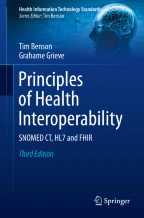CDA – Clinical Document Architecture

CDA (clinical document architecture) is the most widely adopted implementation of HL7 v3. It is used for exchanging information in the form of documents. CDA has three levels: level 1 is a single human-readable document, level 2 can include multiple documents and level 3 can include structured information. Each CDA document has a common header and a variable body part. Templates are used to constrain the generic CDA model. The continuity of care document (CCD) is used to summarize a patients' health record. Consolidated CDA (C-CDA) is a harmonized set of templates for a variety of clinical documents.
This is a preview of subscription content, log in via an institution to check access.
Access this chapter
References
- Benson T. The message is the medium. Health Serv J. 1997;107:(5538; IT update): 4–5. http://abiesuk.blogspot.co.uk/2007/02/all-at-sea.html
- Spronk R. HL7 version 3: message or CDA document? Ringholm Whitepaper, version 1.2, 2007. http://www.ringholm.de/docs/04200_en.htm
- Dolin RH, Alschuler L, Beebe C, Biron PV, Boyer SL, Essin D, Kimber E, et al. The HL7 clinical document architecture. J Am Med Inform Assoc. 2001;8:552–69. ArticleCASPubMedPubMed CentralGoogle Scholar
- Dolin RH, Alschuler L, Boyer S, Beebe C, Behlen FM, Biron PV, Shabo A. HL7 clinical document architecture release 2. J Am Med Inform Assoc. 2006;13:30–9. ArticlePubMedPubMed CentralGoogle Scholar
- Boone KW. The CDA™ book. London: Springer 2011. Google Scholar
- ASTM. Specification for Continuity of Care Record, E2369-05; 2006 Google Scholar
- HL7 Implementation Guide: CDA Release 2 – Continuity of Care Document (CCD). Google Scholar
- Health Level Seven (HL7). Implementation Guide for CDA Release 2: Integrating Health Enterprise (IHE) 9. Health Story Consolidation, Draft Standard for Trial Use (DSTU) Release 1.1 - US Realm, July 2012. Google Scholar
- Companion Guide to HL7 Consolidated CDA for Meaningful Use Stage 2. Standards and Interoperability Framework, Office of the National Coordinator for Health IT, US Health and Human Services 2012. Google Scholar
Author information
Authors and Affiliations
- R-Outcomes Ltd, Newbury, UK Tim Benson
- Health Intersections Pty Ltd, Melbourne, Australia Grahame Grieve
- Tim Benson
You can also search for this author in PubMed Google Scholar

